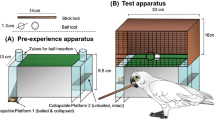Abstract
A tool-throwing task was used to test whether capuchin monkeys understand the difference between functionally appropriate and functionally inappropriate tools. A group of monkeys was trained to obtain a sticky treat from a container outside their enclosure using a projectile attached to one end of an anchored line. Subsequently, these monkeys were given choice tests between functional and nonfunctional versions of tools used in training. A different feature of the tool was varied between alternatives in each choice test. The monkeys chose to use functional tools significantly more often than nonfunctional tools in early exposures to each choice test. A second experiment tested whether these subjects, as well as a second group of minimally trained participants, could distinguish between functional and nonfunctional tools that appeared different from those used in training. A new set of design features was varied between tools in these choice tests. All participants continued to choose functional tools significantly more often than nonfunctional tools, regardless of their tool-throwing experience or the novel appearance of the tools. These results suggest that capuchin monkeys, like chimpanzees studied in similar experiments, are sensitive to a variety of functionally relevant tool features.


Similar content being viewed by others
References
Beck BB (1980) Animal tool behavior: the use and manufacture of tools by animals. Garland, New York
Boesch C, Boesch H (1990) Tool use and tool making in wild chimpanzees. Folia Primatol 54:86–99
Call J (2001) Object permanence in orangutans (Pongo pygmaeus), chimpanzees (Pan troglodytes), and children (Homo sapiens). J Comp Psychol 115:159–171
Chappell J, Kacelnik A (2002) Tool selectivity in a non-primate, the New Caledonian crow (Corvus moneduloides). Anim Cogn 5:71–78
Chevalier-Skolnikoff S (1990) Tool use by wild Cebus monkeys at Santa Rosa National Park, Cost Rica. Primates 31:375–383
Cleveland AC, Rocca AM, Wendt EL, Westergaard GC (2003) Throwing behavior and the mass distribution of stone selection in tufted capuchin monkeys (Cebus apella). Am J Primatol 61:159–172
Fujita K, Kuroshima H, Asai S (2003) How do tufted capuchin monkeys (Cebus apella) understand causality involved in tool use? J Exp Psychol Anim Behav Process 29:233–242
Hauser MD (1997) Artifactual kinds and functional design features: what a primate understands without language. Cognition 64:285–308
Hauser MD (1998) A nonhuman primate’s expectations about object motion and destination: the importance of self-propelled movement and animacy. Dev Sci 1:31–37
Hauser MD, Kralik J, Botto-Mahan C (1999) Problem solving and functional design features: experiments on cotton-top tamarins, Saguinus oedipus oedipus. Anim Behav 57:565–582
Hauser MD, Williams T, Kralik JD, Moskovitz D (2001) What guides a search for food that has disappeared? Experiments on cotton-top tamarins (Saguinus oedipus). J Comp Psychol 115:140–151
Hauser MD, Pearson H, Seelig D (2002) Ontogeny of cotton-top tamarins, Saguinus oedipus: innate recognition of functionally relevant features. Anim Behav 64:299–311
Hunt GR (1996) Manufacture and use of hook-tools by New Caledonian crows. Nature 379:249–251
Klüver H (1933) Behavior mechanisms in monkeys. University of Chicago Press, Chicago
Klüver H (1937) Re-examination of implement-using behavior in a cebus monkey after an interval of three years. Acta Psychol 2:347–397
Kummer H (1995) Causal knowledge in animals. In: Sperber D, Premack D, Premack AJ (ed) Causal cognition, a multidisciplinary debate. Clarendon Press, Oxford, pp 26–39
Limongelli L, Boysen ST, Visalberghi E (1995) Comprehension of cause–effect relationships in a tool-using task by common chimpanzees (Pan troglodytes). J Comp Psychol 109:18–26
Mathieu M, Bouchard MA, Granger L, Herscovitch J (1976) Piagetian object-permanence in Cebus capucinus, Lagothrica flavicauda, and Pan troglodytes. Anim Behav 24:585–588
Parker ST, Gibson KR (1977) Object manipulation, tool use and sensorimotor intelligence as feeding adaptations in Cebus monkeys and great apes. J Hum Evol 6:623–641
Povinelli DJ (2000) Folk physics for apes. Oxford University Press, Oxford
Schino G, Spinozzi G, Berlinguer L (1990) Object concept and mental representation in Cebus apella and Macaca fascicularis. Primates 31:537–544
Tebbich S, Taborsky M, Fessl B, Blomqvist D (2001) Do woodpecker finches acquire tool-use by social learning? Proc R Soc Lond B 268:2189–2193
Tomasello M, Call J (1997) Primate cognition. Oxford University Press, Oxford
Tomonaga M (2001) Visual search for biological motion patterns in chimpanzees (Pan troglodytes). Psychologia 44:46–59
Visalberghi E, Limongelli L (1994) Lack of comprehension of cause-effect relations in tool-using capuchin monkeys (Cebus apella). J Comp Psychol 108:15–22
Visalberghi E, Trinca L (1989) Tool use in capuchin monkeys: distinguishing between performing and understanding. Primates 30:511€“521
Visalberghi E, Fragaszy DM, Savage-Rumbaugh S (1995) Performance in a tool-using task by common chimpanzees (Pan troglodytes), bonobos (Pan paniscus), an orangutan (Pongo pygmaeus), and capuchin monkeys (Cebus apella). J Comp Psychol 109:52–60
Weir AAS, Chappell J, Kacelnik A (2002) Shaping of hooks in New Caledonian crows. Science 297:981
Westergaard GC (1999) Structural analysis of tool-use by tufted capuchins (Cebus apella) and chimpanzees (Pan troglodytes). Anim Cogn 2:141–145
Westergaard GC, Fragaszy DM (1987) The manufacture and use of tools by capuchin monkeys (Cebus apella). J Comp Psychol 101:159–168
Westergaard GC, Suomi SJ (1994) Aimed throwing of stones by tufted capuchin monkeys (Cebus apella). Hum Evol 9:323–329
Westergaard GC, Liv C, Chavanne TJ, Suomi SJ (1998) Token-mediated tool-use by a tufted capuchin monkey (Cebus apella). Anim Cogn 1:101–106
Westergaard GC, Liv C, Haynie MK, Suomi SJ (2000) A comparative study of aimed throwing by monkeys and humans. Neuropsychology 38:1511–1517
Wood S, Moriarty KM, Gardner BT, Gardner RA (1980) Object permanence in child and chimpanzee. Anim Learn Behav 8:3–9
Acknowledgements
This research was supported by the National Institute of Health grant no. R03HD39647-01A1 and was conducted in compliance with the laws and ethical standards of the United States of America. We thank Dr. Sue Howell for her comments on the manuscript and for her assistance with data analysis.
Author information
Authors and Affiliations
Corresponding author
Rights and permissions
About this article
Cite this article
Evans, T.A., Westergaard, G.C. Discrimination of functionally appropriate and inappropriate throwing tools by captive tufted capuchins (Cebus apella). Anim Cogn 7, 255–262 (2004). https://doi.org/10.1007/s10071-004-0220-4
Received:
Revised:
Accepted:
Published:
Issue Date:
DOI: https://doi.org/10.1007/s10071-004-0220-4




